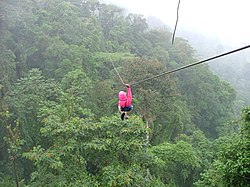Longest
The world's longest zip-line, which opened on 28 September 2024, is the K3 of the SA Forest Adventures in Caledon, South Africa. It is a single cable of 3.2 kilometres (2.0 mi) reaching speeds up to 120 kilometres per hour (75 mph). [31]
The previous record holder was the "Jebel Jais Flight", which was sited on one of the peaks of the Jebel Jais mountain in Ras Al Khaimah, United Arab Emirates, with a single unbroken span of 2,831.88 metres (9,290.9 ft). [32] [33] The ride, which opened in 2018, was temporarily [34] closed later that year pending the outcome into an investigation into the fatal crash of an Agusta 139 rescue helicopter that was believed to have clipped one of the ride's cables. [35]
The "Parque de Aventura Barrancas del Cobre" at 2,545 m (8,350 ft) in Copper Canyon, Mexico, is the second-longest span, [36] with "El Monstruo" at Orocovis in Puerto Rico coming in third, at 2,530 m (8,300 ft). [37]
The Skywire at Bluewater in Kent is the longest in England at 725 metres (2,379 ft). [38] The longest zip-line in Europe, at 2,300 metres (7,500 ft), is the Sternsauser in Hoch-Ybrig, Switzerland. [39]
The Zip World Bethesda line in Penrhyn Quarry, Bethesda, Wales holds the world record for attaining the fastest zip-line travel speed. [40] [41]








